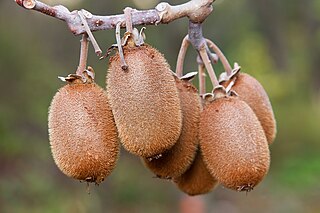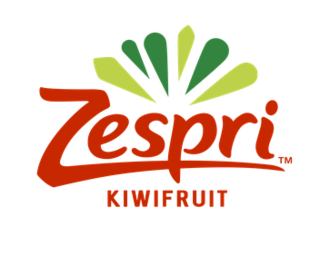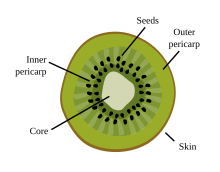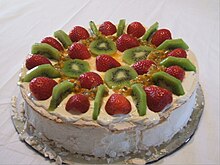
A mango is an edible stone fruit produced by the tropical tree Mangifera indica. It originated from the region between northwestern Myanmar, Bangladesh, and northeastern India. M. indica has been cultivated in South and Southeast Asia since ancient times resulting in two types of modern mango cultivars: the "Indian type" and the "Southeast Asian type". Other species in the genus Mangifera also produce edible fruits that are also called "mangoes", the majority of which are found in the Malesian ecoregion.

Actinidia is a genus of woody and, with a few exceptions, dioecious plants native to temperate eastern Asia, occurring throughout most of China, Taiwan, Korea, and Japan, and extending north to southern areas of Russian Far East and south into Indochina. The genus includes shrubs growing to 6 metres tall, and vigorous, strong-growing vines, growing up to 30 m (100 ft) in tree canopies. They mostly tolerate temperatures down to around −15 °C (5 °F), and some are much hardier.

Prunus cerasus is a species of Prunus in the subgenus Cerasus (cherries), native to much of Europe, North Africa and West Asia. It is closely related to the sweet cherry, but has a fruit that is more acidic. Its sour pulp is edible.

The cucumber is a widely-cultivated creeping vine plant in the family Cucurbitaceae that bears cylindrical to spherical fruits, which are used as culinary vegetables. Considered an annual plant, there are three main types of cucumber—slicing, pickling, and seedless—within which several cultivars have been created. The cucumber originates in Asia extending from India, Nepal, Bangladesh, China, and Northern Thailand, but now grows on most continents, and many different types of cucumber are grown commercially and traded on the global market. In North America, the term wild cucumber refers to plants in the genera Echinocystis and Marah, though the two are not closely related.

The avocado, alligator pear or avocado pear is a medium-sized, evergreen tree in the laurel family (Lauraceae). It is native to the Americas and was first domesticated in Mesoamerica more than 5,000 years ago. Then as now it was prized for its large and unusually oily fruit. The tree likely originated in the highlands bridging south-central Mexico and Guatemala. Avocado trees have a native growth range from Mexico to Costa Rica. Its fruit, sometimes also referred to as an alligator pear or avocado pear, is botanically a large berry containing a single large seed. Sequencing of its genome showed that the evolution of avocados was shaped by polyploidy events and that commercial varieties have an hybrid origin. Avocado trees are partly self-pollinating, and are often propagated through grafting to maintain consistent fruit output. Avocados are presently cultivated in the tropical and Mediterranean climates of many countries. Mexico is the world's leading producer of avocados as of 2020, supplying nearly 30% of the global harvest in that year.

Pollination of fruit trees is required to produce seeds with surrounding fruit. It is the process of moving pollen from the anther to the stigma, either in the same flower or in another flower. Some tree species, including many fruit trees, do not produce fruit from self-pollination, so pollinizer trees are planted in orchards.

Pollination management is the horticultural practices that accomplish or enhance pollination of a crop, to improve yield or quality, by understanding of the particular crop's pollination needs, and by knowledgeable management of pollenizers, pollinators, and pollination conditions.

Passiflora edulis, commonly known as passion fruit, is a vine species of passion flower native to the region of southern Brazil through Paraguay to northern Argentina. It is cultivated commercially in tropical and subtropical areas for its sweet, seedy fruit.

The tamarillo is a small tree or shrub in the flowering plant family Solanaceae. It is best known as the species that bears the tamarillo, an egg-shaped edible fruit. It is also known as the tree tomato, tomate de árbol, tomate andino, tomate serrano, blood fruit, poor man's tomatoe, tomate de yuca, tomate de españa, sachatomate, berenjena, chilto and tamamoro in South America, tyamtar, rambheda or rukh tamatar in Nepal, and terong Belanda in Indonesia. It is popular globally, especially in Peru, Colombia, New Zealand, Ecuador, Nepal, Rwanda, Burundi, Australia, and Bhutan.
HortResearch was a Crown Research Institute of New Zealand. The focus of research in this company was mainly in the development of new fruit varieties and other food products. It was probably most recognised for its plant breeding of various kiwifruit varieties, including new cultivars of Actinidia (genus) chinensis and arguta (species).

Actinidia arguta, the hardy kiwi, is a perennial vine native to Japan, Korea, Northern China, and the Russian Far East. It produces a small kiwifruit without the hair-like fiber covering the outside, unlike most other species of the genus.

Solanum muricatum is a species of evergreen shrub native to South America and grown for its sweet edible fruit.

Actinidia deliciosa, the fuzzy kiwifruit, is a fruiting vine native to Southern China. Other species of Actinidia are also found in China and range east to Japan and north into southern areas of Russian Far East. This species grows naturally at altitudes between 600 and 2,000 m.

Actinidia chinensis(Planch.), known commercially as the golden kiwifruit, is a fruiting vine, native to China. It is one of some 40 related species of the genus Actinidia, and closely related to Actinidia deliciosa, which is the source of the most common commercial kiwifruit. Fruit colour may vary from green to lime green or gold, depending on breeding.

Actinidia kolomikta, the kolomikta, miyamatatabi, super-hardy kiwi, or variegated-leaf hardy kiwi, is a species of flowering plant in the family Actinidiaceae, native to temperate mixed forests of the Russian Far East, Korea, Japan and China.

Kiwifruit or kiwi is a major horticultural export earner for New Zealand. New Zealand developed the first commercially viable kiwifruit and developed export markets, creating the demand for the fruit that exists today. Today New Zealand is the third largest kiwifruit producing country, next to China and Italy, and holds approximately 30% of the market share. In the 2008–2009 season the value of New Zealand kiwifruit exports was NZ$1.45 billion.
Actinidia melanandra, known as purple kiwi or red kiwi is a fruiting plant in the genus Actinidia, which contains three commercially grown species of kiwifruit. The plant is native to parts of Hubei, Sichuan, and Yunnan provinces of China. The fruit has a fuzzy purple skin with reddish flesh. Although the fruit is edible, is not commercially cultivated, however it is occasionally sold as a landscape plant under the erroneous name Actinidia melandra.
Allan Ross Ferguson is a New Zealand botanist who has made significant contributions in the field of kiwifruit scientific investigation. The standard author abbreviation A.R.Ferguson is used to indicate this person as the author when citing a botanical name.

Zespri International Limited is the world's largest marketer of kiwifruit, selling in over 50 countries. Its international headquarters are in Mount Maunganui, New Zealand. However, it has licensed growers in Italy, France, Japan, South Korea, Greece and Australia, with trials in place in several other countries. Kiwifruit from New Zealand is available from May to October. To satisfy year-round consumer demand, Zespri markets kiwifruit from Italy from November to January.

The gold kiwifruit or yellow kiwi is a variety of kiwifruit developed by the company Zespri International Ltd. The yellow kiwi is a different species but of the same genus as the green one.




























